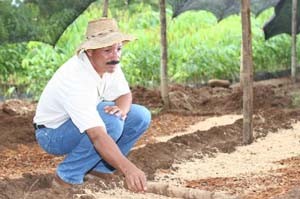
Rubiel Zapata always dreamed of growing rubber. A certified teacher who lived in his hometown of Uré, he taught in rural schools in the northern Colombian department of Córdoba for five years before “the violence in the region forced me to leave,” he said.
But sixteen years would elapse from the time he started teaching until he committed himself to planting rubber trees. “I knew nine families who had started to grow rubber trees. But they all gave up. Every day, on my way to the school, I saw the trees they had thrown onto the roadside, more than 1,300 in total. One day I picked them up, and started replanting. Today, rubber from my trees is the main source of income for my family,” he said.
Rubiel understood the desperate need in the region for legal sources of income for local farmers. He gradually became convinced that rubber would be a superior crop to coca, and began to organize ASOCUR (the Farmers’ Association of Uré). After receiving USAID funding, Rubiel and other farmers were in business.
Their goal is to grow 848 hectares (2,100 acres) of rubber in Uré. “We currently have a rubber nursery with a production capability of one million rubber trees per year. There are 151 beneficiary families, and 120 have planted an average of four hectares (10 acres) each. The other 31 families are just beginning to plant nurseries on their own land. You know, rubber not only generates an income, but it also helps to conserve the water, land, and air. Our new goal is to plant 5,000 hectares (more than 12,000 acres) of rubber trees in 10 years. We believe we will be able to generate up to $25 million per year from rubber production,” he said.
Rubiel said, “I have no idea how I didn’t become a coca grower after all the things people used to tell me. But I always dreamed of growing rubber. And now, through ASOCUR, we have been able to show that the problem [of growing coca] can be nipped in the bud. This is a whole learning process and I am convinced that we will find new alternatives to continue it.”







Comment
Make a general inquiry or suggest an improvement.